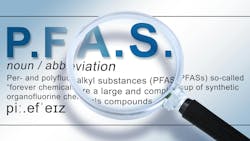The environmental dental hygienist: Ways to bring awareness to what’s in our dental products
Now more than ever, dental providers, patients, and product companies are looking to environmentally conscious ways to deliver oral health-care services. Between personal oral hygiene products and supplies used in the dental office, significant amounts of waste that are unable to biodegrade are produced. Just recently, the state of Colorado announced that starting in 2026, it will ban the sale of everyday products that intentionally contain polyfluoroalkyl substances (PFAS), the “forever chemicals” that are linked to increased cancer risk, lower fertility, and developmental delays. Products containing these chemicals include cookware, menstruation products, cleaning products, cosmetics, clothing, and some coated dental floss.1
In dentistry specifically, eliminating these substances from the products we use and educating patients on their long-term health effects could help reduce the environmental impact of these items. This article aims to provide an overview of PFAS, where they are seen within oral health care, and what actions dental professionals can take to be environmentally conscious when recommending dental products to patients.
What are PFAS?
As mentioned previously, PFAS are human-made fluorinated compounds that are found in many day-to-day products. Their widespread use comes from their ability to repel water, heat, stains, and oil on the surfaces of many materials.2 The concern with these substances is that they degrade very slowly, so they have a significant impact on the environment and personal health.
PFAS are made up of carbon and fluorine atoms, which is an extremely strong bond that gives them hydrophobic and lipophobic properties. Depending on the number of carbon atoms present delineates whether the PFAS are short- or long-chain.3 The longer the carbon chain, the more PFAS are suspected to accumulate in the environment. Short-chain PFAS can last as long as long-chain PFAS, but they are able to move readily in plants, animals, bacteria, soil, and water. Contrary to long-chain, short-chain PFAS are more difficult to remove from large bodies of water because they easily repel water.3 There are more than 4,730 different types of PFAS and their half-lives are unknown; however, there have been estimates of half-lives over 1,000 years in soil and over 40 years in water.4 One can begin to see why these substances are termed “forever chemicals.”
Exposures to PFAS have been linked to increased risks for cancer, asthma, altered immune response, thyroid conditions, liver function, kidney damage, and altered pregnancy outcomes.3 A systematic review and meta-analysis that evaluated the association between PFAS and reproductive hormones in humans concluded that PFAS affect reproductive hormones by regulating gene expression.5 Through analysis of various study outcomes, a statistically significant association was determined between perfluorooctanoic acid (PFOA) and perfluorooctanesulfonic acid (PFOS)—a subgroup of PFAS—and testosterone levels in males. There was also a statistically significant correlation between perfluorohexanesulfonate (PFHxS)—another subgroup of PFAS—and estradiol levels in females.5
Although PFAS are found in numerous products, humans are most often exposed through dietary sources, contaminated water, inhalation of dust or air particles, and absorption through the skin.3 Most PFAS are not metabolized and are typically eliminated through urine, defection, menstruation, breastfeeding, and through the placenta.
According to the National Health and Nutrition Examination Survey (NHANES), blood levels of PFAS have continually reduced since 1999 due to the Environmental Protection Agency (EPA) enacting regulation within manufacturers to reduce emissions of PFAS.6 However, vigilant efforts must continue toward reduction of these substances and other chemicals that do not biodegrade, especially in oral health-care products.
PFAS in dentistry
These “forever chemicals” may be residing in products one may not have considered. Most notably, PFAS have been found in some types of dental floss along with nylon or polyester, which is what allows these floss products to slide easily between teeth.7 Interestingly, federal law does not require companies to be completely transparent in the ingredients or materials that are used in floss, which can make it difficult for clinicians and patients alike to decide which products are best for them.7
A study evaluated the potential effects of PFAS on individual health and the environment from leave-in dental products such as night guards and whitening trays. Several different PFAS were measured, and it was determined that the concentrations in night guards were similar to those in dental floss and tape, which were only found at trace levels. This study looked at the potential for PFAS leaching through use of these products as well as their environmental impact when disposed into landfills.8 Daily use of these products contribute far less than what is found in food, soil, and drinking water, but PFAS are still prevalent in these products. Dental manufacturers are considering ways to develop products without these substances.
Another study conducted in 2022 evaluated 39 different brands of floss for PFAS and found the chemicals in a third of the samples. The amounts ranged from 11 parts per million (ppm) to 248,900 ppm.9 Research appears minimal at this time, although awareness of these substances and their influence on environmental and individual health is rising.
Reducing PFAS and considering biodegradable options
The role of the dental professional in acting toward eliminating use of products with PFAS comes down to clinician preferences and beliefs. It is likely that a patient may have used a certain product for years that could potentially contain PFAS, but they are not willing to make a change. Bringing patient awareness to the impact these ingredients have on the environment and overall health over time is critical. Helping patients make informed decisions not only about the products they are using but also where their food is coming from and what is in their water are all ways we can become more diligent in eliminating the use of PFAS.
Many companies are also looking toward ways to eliminate waste of their products. In the dental operatory, items such as disposable high-volume evacuator and air-water syringe tips made of recycled plastic, biodegradable face masks, saliva ejectors made from sugar canes, and biodegradable gauze are a few options to help reduce our carbon footprint. For personal oral hygiene, products such as bamboo toothbrushes, silk floss, and toothpaste tablets serve as alternatives to reduce plastic and waste.
Although these options may not be for every patient or clinician, it is important to be aware of product alternatives for those wanting to reduce their consumption of PFAS or excessive dental office waste.
Small steps through patient education
Substances that take years to biodegrade are prevalent in the foods we eat, the water we consume, and the products we use. Emerging research is pointing to these “forever chemicals” as contributors to a number of health conditions. This is leading product manufacturers to consider alternatives to what has been done in the past so that healthier options for the environment and individual health can be prioritized. As oral health-care providers, we can take small steps toward reducing our carbon footprint by educating patients on zero-waste oral care products and incorporating biodegradable options into the dental operatory.
References
- Weis K. New Colorado law will ban sales of dental floss, clothes, & other household products containing toxic “forever chemicals.” CBS News. Updated June 24, 2024. Accessed July 1, 2024. https://www.cbsnews.com/colorado/news/new-colorado-law-ban-sales-dental-floss-clothes-household-products-containing-toxic-forever-chemicals/
- ChemSec SIN List. Accessed July 1, 2024. https://sinlist.chemsec.org/chemical-groups/fluorinated-compounds/
- India-Aldana S, Yao M, Midya V, et al. PFAS exposures and human metabolome: a systematic review of epidemiological studies. Curr Pollut Rep. 2023;9(3):510-568. doi:1007/s40726-023-00269-4
- PFAS the ‘forever chemicals’: invisible threats from persistent chemicals. CHEM Trust. Accessed July 3, 2024. https://chemtrust.org/pfas/
- Li L, Guo Y, Ma S, Wen H, Li Y, Qiao J. Association between exposure to per- and perfluoroalkyl substances (PFAS) and reproductive hormones in human: a systematic review and meta-analysis. Environ Res. 2024;241:117553. doi:1016/j.envres.2023.117553
- PFAS Information for Clinicians – Agency for Toxic Substances and Disease Registry. Reviewed January 18, 2024. Accessed July 2, 2024. https://www.atsdr.cdc.gov/pfas/resources/pfas-information-for-clinicians.html
- Cook S. How to choose dental floss without PFAS and other harmful chemicals. Consumer Reports. April 10, 2024. Updated May 15, 2024. Accessed July 2, 2024. https://www.consumerreports.org/toxic-chemicals-substances/dental-floss-without-pfas-and-other-harmful-chemicals-a9722832754/
- Massarsky A, Parker JA, Gloekler L, et al. Assessing potential human health and ecological implications of PFAS from leave-in dental products. Toxicol Ind Health. 2024;40(3):91-103. doi:1177/07482337231224990
- Fischer D. Tests find PFAS abundant in some dental floss. Environmental Health News. September 14, 2022. Accessed July 8, 2024. https://www.ehn.org/pfas-floss-2658203711/better-flossing-products
About the Author

Annie Walters, MSDH, RDH
Annie Walters, MSDH, RDH, attended Northern Arizona University, where she spent time caring for individuals in Guatemala and Indian Health Service. She has a special interest in advancing access to care for individuals with specialized health-care needs. She’s a member of ADHA, and received her MS from the University of New Mexico, where she developed a chairside resource for RDHs to use for patients with specialized needs. She practices in Flagstaff, Arizona, and serves as part-time faculty at her alma mater. Contact her at [email protected].

